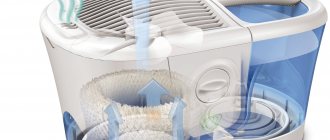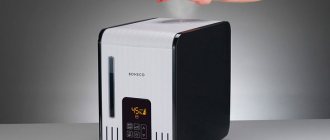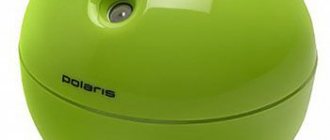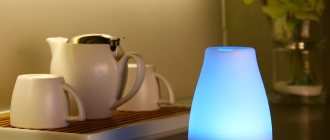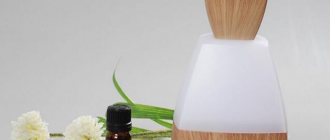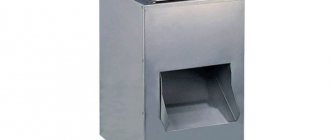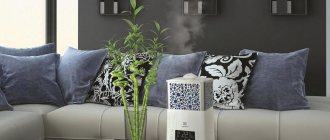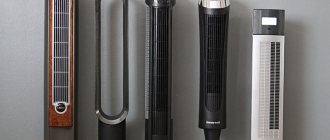- Factors influencing climate in production and industry
- Where are industrial humidifiers needed?
- Humidity value
- Operating principles
- Types of industrial humidifiers
- Types of Humidifiers
- Ultrasonic humidifiers
- Automatic humidification system for air fogging in industrial premises
- Block diagram of an automatic high-pressure air humidification/fogging system
Send a quick request Air humidification is an important component of an optimal microclimate not only for humans.
Many technological and manufacturing processes also require maintaining optimal humidity levels to ensure the production of quality products. Air humidification in production areas is becoming increasingly important in many industries. Modern requirements for temperature and humidity conditions lead to the need to use air humidification systems in technological processes.
INTECH-Climate is ready to implement professional solutions for climate control and other engineering equipment. We will carry out a full cycle of turnkey work: design, selection, delivery, installation and maintenance. Call now: +7 (495) 146-65-64
. Submit your application
Factors influencing climate in production and industry:
- during the heating season, the level of air humidification at the enterprise is reduced to 12%-14%, with the norm being 45%-60%;
- when modernizing equipment, air exchange increases, which leads to a decrease in normal air humidity;
- Low air humidity increases the production of defects, leads to damage to raw materials and finished products, which sharply increases the cost of production.
Undoubtedly, creating a favorable climate in industry not only makes it possible to meet the high modern requirements for production premises.
In many industries, maintaining a certain level of humidity becomes one of the factors of production:
- air humidification in printing houses is becoming increasingly important during the printing process;
- in the woodworking and furniture industries, the moisture content in wood is directly related to the temperature and level of humidity in the room;
- in the textile industry, the level of fabric moisture is directly related to increasing the tensile strength of natural fibers and reducing the number of defects;
- Air humidification in agriculture and the tobacco industry also plays an important role.
And most importantly, additional air humidification in the company has a beneficial effect on the well-being of staff.
Where are industrial humidifiers needed?
The presence of special climatic conditions is necessary in various production areas - problems with dry air are common in many production workshops and warehouses. The rooms that most need humidification of air masses are:
- Base and server stations. Since dry air allows the accumulation of excessive charges of static electricity, this contributes to the creation of threats to the normal work process.
- Museums and libraries. The presence of a stable microclimate will ensure the safety of exhibits and printed publications.
- Printing houses. During the production of printed products, air humidity must be maintained at an optimal level so as not to lead to a decrease in the quality characteristics of the paper.
- Textile industry. Since low air humidity affects the strength characteristics of fabrics, equipping workshops with humidifiers is simply necessary.
- Woodworking industry. Wood, in order to preserve all its qualities, simply needs to be in an optimal humidity environment so that cracks, splits and deformations do not occur.
- Medical and pharmaceutical purposes. An optimal level of humidity should be maintained both in places of production of medical drugs and in places of their storage, and even in places of direct use - in medical institutions.
The variety of applications leads to the availability of many types of industrial air humidifiers.
How to choose the right one
The choice of the type of humidifying device should be based on taking into account various factors:
- The type of production facility and its main purpose.
- Required device performance.
- The need to strictly maintain the humidity level or simply maintain it within certain limits.
- Needs manual or automatic control.
Only taking into account all possible factors will allow you to choose a truly effective industrial humidifier for the given conditions. For example, air washers are not recommended for use in rooms that require precise maintenance of a set humidity level. Therefore, humidifiers of this type are best suited for:
- Office premises.
- Printing houses.
- Kindergartens and schools.
- Radioelectronic production.
- Server rooms.
- Archives of museums and libraries.
It is advisable to use industrial humidifiers of the steam generator type in industrial premises with the need to accurately maintain specified humidity parameters - laboratories, operating rooms, sterile rooms, etc.
Ultrasonic humidifiers are most effective when used in refrigerators, vegetable stores, wine cellars, furniture and antique showrooms, woodworking factories, and painting booths.
Humidity value
Air humidity plays an important role in the functioning of the human body. Using climatic devices it is possible to significantly extend the shelf life of vegetables, fruits and other goods. The general atmosphere in the room also affects the quality of the product. Manufacturers must carefully consider the appropriateness of the devices and the functions of the devices they purchase. An industrial steam humidifier has a positive effect on people's well-being. Labor productivity increases and the risk of fatigue decreases. Otherwise, depression may occur and the person may become ill.
Air humidification systems in industrial premises should be used in conjunction with the following units:
- Heating and other types of heating devices.
- Air conditioning in the hot season.
- The room requires long-term air exchange in dry weather.
- An industrial steam humidifier is necessary in certain industries and areas of human activity. The condition is considered mandatory. In the absence of a device, the risk of property damage increases or the quality of the finished product deteriorates.
Industrial air and its components are monitored using special instruments. Thanks to them, it is possible to achieve optimal condition in any room.
An industrial humidifier can have different capacities. The indicator is calculated depending on the area of the room. Its purpose and other parameters are also taken into account.
The best air purifiers for an area of 25 square meters or more. m
The main criterion for choosing an air purifier is the area of the room. The operation of the following 3 models presented in the expert rating applies to a room larger than 25 square meters. m. They can be installed in private homes, large work offices and large apartments. The best were those nominees whose high power goes along with the best price, good build quality, and the presence of the most popular functions.
Xiaomi Mi Air Purifier Max
If we consider all Xiaomi air purifiers, reviews confirm that the Xiaomi Mi Air Purifier Max model is considered the most powerful and high-quality. Every declared option from the manufacturer is impressive, starting from a sink to 120 sq. m. at a maximum speed of 1000 cubic meters, ending with high starts of work (when turned on for 3 minutes, the space is disinfected with an area of up to 21 sq. m.). Here you can see a laser sensor, temperature and humidity level sensors, thanks to which you can control the operating mode and key indicators. Filters destroy dust, formaldehyde, odors, and solid microparticles.
Advantages
- OLED screen with operating information;
- Three-layer filter;
- Ability to adjust brightness and power;
- Automatic selection of the optimal operating mode;
- Floor installation;
- Highest performance;
- Minimal noise.
Flaws
- Expensive filters;
- The disc drum humidifier must be washed so that there is no smell.
Despite the fact that one filter will cost about 3,000 rubles, in reality it will last about a year, which means the costs are completely justified. If there are a lot of unpleasant odors in the room, the humidifier may become dirty, so it will have to be washed more often. Despite its rather large dimensions, the device copes with a large room in a matter of minutes.
Redmond RAC-3708
Air purification and filtration using such a device allows you to retain particles of pollen and dust, bacteria and viruses, neutralize the spread of allergens, in addition, filters neutralize various unpleasant odors. Based on these options, the Redmond RAC-3708 is a good home air purifier for allergy sufferers and frequently ill people, serving up to 40 square meters. m. Multi-level cleaning system (three filters - carbon, HEPA filter H13, ultraviolet) demonstrates disinfection efficiency of 99.95%. The buttons on the panel allow you to select different blowing speeds, the timer activates the shutdown option.
Advantages
- Touch control;
- LED indication;
- Ionization option;
- Air exchange up to 215 m³/h;
- Preventing the spread of allergens.
Flaws
- High price;
- Short cord.
The device copes well with the most unpleasant odors, such as tobacco smoke, and captures not only large but small particles. With active use, the filters last for 4-5 months; it is better to buy those replacement kits that are produced by the same brand.
The best air conditioners for home and apartment according to customer reviews
Operating principles
An industrial humidifier is a device whose main purpose is to provide proper humidification of air masses on a large scale. Despite the variety of devices for air humidification in production, they all work based on one of two principles:
- Adiabatic.
- Isothermal.
The action of humidifiers that have an adiabatic operating principle is based on the natural process of evaporation. The air flow absorbs moisture, subsequently converting it into steam. Since this process requires considerable energy consumption, it is accompanied by a decrease in the air temperature in the room.
The action of isothermal humidifiers is based on mixing air with the generated steam. This type of industrial humidifiers does not change the air temperature in the room during operation.
Classification of systems by pressure level
Typically, industrial-type humidifiers are divided into low- and high-pressure models. The first category is characterized by quick installation and the ability to start a humidification system by connecting a compressor that directs compressed air. These are compact units that provide an average output of 50 l/h. Such equipment in standard modifications is used in small warehouses where it is necessary to maintain optimal humidity levels for storing hygroscopic materials - for example, veneer, paper, etc. For more serious tasks, a high-pressure humidifier is designed. Industrial units of this type provide productivity up to 2,500 l/h. Equipment with such capabilities requires more energy consumption, but is capable of guaranteeing normalization of the air environment in difficult conditions at construction plants, large greenhouses, printing houses, etc.
We recommend reading: Pellet boilers - what they are, what fuel they use, design and nuances of choice
Types of industrial humidifiers
The most commonly used industrial humidifiers are the following types:
- Sprayers.
- Working on ultrasound.
- Sinks.
Sprayers (also called atomizers) work on the principle of aerosols, spraying drops of moisture at certain time intervals. Devices of this type are equipped with a certain number of sensors, depending on the manufacturer and model. Sensors allow you to regulate the operation of the humidifier based on the specified temperature and humidity parameters of the air.
Installation and maintenance
An industrial ultrasonic humidifier does not require installation and includes a set of activities that require certain knowledge and skills. Therefore, such a task should always be trusted to professionals. The work begins with choosing a convenient location. It is installed on a hard and flat surface. For wall mounting, you must purchase a set of brackets. After this, the hydraulic connections and drainage system are established. Next, the power supply is connected. Also at this stage the sensor (included) is installed. Installation work is completed with the installation of steam distributors, trial run and debugging.
Maintenance must be regular - at least once a month. The specialist will clean the functional elements from solid deposits, replace the replaceable filter element and promptly identify faults that may lead to malfunction of the device.
Types of Humidifiers
The operation of all humidifiers is based on one of the methods of processing moisture into gas (isothermal or adiabatic); there are different types of humidifiers. Let's look at how different they are and what their positive and negative aspects are.
Types of humidifiers:
- Heating humidifier. It consists of several elements: a tank for heating water, a heating element, a hose that discharges steam into the air duct, a tube with holes that evenly distributes steam into the air. The resulting steam will be superheated to avoid condensation forming inside the device.
- Infrared humidifier. It is designed in the same way as the previous humidifier, only the heating element here is infrared lamps.
- Electrode humidifier. It produces steam due to the phenomenon of water dissociation, i.e. Voltage is applied to the electrodes (anode and cathode) lowered into the water, an electric current is released, the water heats up and begins to be converted into steam.
- Evaporative humidifier. Evaporation of moisture in it is achieved by blowing air onto water, which, in turn, is applied to the surface intended for this purpose (most often the surface is made of plastic or paper).
- Disintegrating humidifier. Splits water into many small particles under pressure (using a water pump or using compressed air). After this, the resulting fine particles are sprayed into the air stream and evaporate.
- Ultrasonic humidifier. The latest development works as a membrane that vibrates intensely, onto which water falls and is very quickly sprayed into a whole cloud of microparticles. The air that passes through this cloud is instantly saturated with moisture.
When using any type of industrial humidifiers, you should ensure that the water that is to be treated is purified. This is necessary to ensure that the air does not become polluted.
Types of PUV
Both of these technologies are widely used in practice. Any industrial humidifier operates using one of these methods. The types of humidifiers are:
- Heating. Its components:
- heating component;
container for heating water;
- hose for releasing steam into the air duct;
- a tube with holes - it evenly directs steam into the air.
- Infrared. The components are the same as in paragraph 1. Only the IR lamps are responsible for heating here.
- Electrode. The essence: electrodes are lowered into water. There follows tension. An electric current appears. The water temperature rises. Water becomes steam.
- Evaporative. The water is blown with air and applied to a special plastic or paper surface. Due to this, moisture evaporates.
- Disintegrating. Principle: water is split into many small particles. They are exposed to pressure from a special pump. They are then distributed into the air. They evaporate.
- Ultrasonic. This is an innovative technique. Operates on the principle of a membrane. It vibrates intensely. Water ends up on it and is rapidly sprayed into a huge volume of microparticles. And the air follows through it and saturates it with moisture.
The generated steam overheats. Thanks to this, there is no accumulation of condensation inside the device.
When using any of the indicated types, you need to control the purity of the water intended for treatment. This is a measure to avoid air pollution.
Ultrasonic PUV
Today the demand for them is impressive. Ultrasound creates a cloud. It spreads throughout the entire room. The cloud is naturally converted into steam. This is how the required humidity develops. To prevent dangerous elements from this cloud from getting onto clothing, objects and various equipment, special filters are installed in ultrasonic PUVs. They look like cartridges. If necessary, they can be changed.
When using this type of humidifier, you can carefully control the humidity level throughout the room. Such devices have automatic control over performance. The resulting daily value is more than 10 liters. And warm steam can be produced at a modest noise level.
Steam humidifiers
Steam humidifiers, as you might guess, provide humidification from the air by spraying hot steam. The operating principle of such a device is very simple: water is supplied to a special container in which it is heated and evaporated. Such a device will not require special filters for cleaning and will be easy to maintain. You will have to pay for this with increased energy consumption and, as a result, an increase in the temperature in the room (which, however, can also be interpreted as an advantage if the humidifier is intended to be used where heating would not interfere). An additional advantage is that humidification occurs with steam - that is, in fact, with distilled water.
But the increased noise level cannot be called an advantage: not everyone will like using a steam humidifier in the bedrooms. There have also been complaints that such devices dry out indoor plants, and if the power of the device is chosen incorrectly (if the humidifier is too powerful, or if it is installed in too small a room), it is easy to create a sauna effect in the room.
Steam humidifier Stadler Form Fred F-008EH with a fun design
Traditional humidifiers
Traditional humidifiers humidify the air by “blowing” it through a cassette, filter, or other object heavily moistened with water. Thus, they work on the principle of natural evaporation. These devices consume relatively little electricity (from 20 to 60 W) and moderately purify the air during operation by settling some of the dust in the water. The key disadvantages of such devices are their relatively low performance and the need to regularly change the water (it gets dirty) and the filter/cassette (however, some can be washed multiple times - then you can change them, for example, once a year). The main advantage is that with this method of humidification, the air is humidified the worse, the higher its humidity - thus, the optimal level of humidity begins to be maintained automatically over time. Well, cleaning the air from dust is also a useful function.
Traditional humidifier Boneco Air-O-Swiss
Ultrasonic humidifiers
These are the most popular and in demand humidifiers today, let's figure out why?
As we said, with the help of ultrasound, something like fog is created, which spreads throughout the room, after which, in a natural way, this fog turns into steam, and this leads to an increase in air humidity.
To ensure that harmful impurities located in the separated water cloud (various salts, microorganisms, etc.) do not remain on furniture, clothing and technical devices, ultrasonic humidifiers are equipped with special filters. Typically, they are made in the form of cartridges that can be replaced when necessary.
In addition, ultrasonic humidifiers are capable of precise control over the humidity level of the entire room. Using an ultrasonic humidifier, you can achieve almost 100% air humidity. They are economical because they have an automatic control program and a capacity of more than 10 liters per day. Only an ultrasonic humidifier can produce warm steam at a low noise level.
But, like any device, industrial air humidifiers have their own characteristics and disadvantages. The disadvantages include the fact that the capacity of an ultrasonic humidifier is limited in size, which is why it needs to be constantly replenished with water. Also, if you do not replace the filter cartridge after 4 months of its operation, salt deposits will appear on various household items surrounding the device.
When choosing ultrasonic humidifiers, remember that their use is absolutely harmless to human health, because the ultrasound in them only causes the membrane to move. No other method except ultrasonic can achieve such frequent vibrations.
When thinking about purchasing an air humidifier, be it industrial or household, ultrasonic or electrode, remember that you cannot skimp on your own health and the health of others. You should choose the most suitable option, the most harmless and effective.
What is the device for?
In modern residential premises, the moisture level is very far from optimal levels for human health. This is especially true during the cold period of the year, when the heating is turned on in the apartments. For a healthy lifestyle, a person needs an atmosphere with a humidity of 45–60%, but in fact it turns out no more than 25%, in rare cases – 40%.
It is because of this indicator that people experience unexplained headaches, skin problems begin and immunity decreases significantly. In addition, dry air negatively affects indoor plants and furniture. To increase humidity, until recently they hung wet laundry in the room or sprayed water with a spray bottle. However, now, in the age of high technology, it is enough to purchase a suitable humidifier that can create a comfortable atmosphere for both a person and room equipment. Before buying a device, you need to take a closer look at its existing types and functions. To do this, it is recommended to watch a video on this topic, or read this article.
Automatic humidification system for air fogging in industrial premises
Designed to automatically maintain a given air humidity in industrial premises.
The principle of operation of the system is to increase the water pressure of the system to a certain value using a high-pressure piston pump. Water under a pressure of 70-200 atm through a high-pressure pipeline is sprayed with special nozzles (nozzles) with particles up to 5 microns in size, i.e. When sprayed, the water turns into a state of saturated steam - fog. Water particles (fog) when sprayed absorb heat from the air and thereby humidify the air and reduce its temperature
The water spray nozzle is made using titanium alloy materials and has a pressure limiting valve. The body is made of copper materials or stainless steel. The nozzles have the following characteristics: atomizing water to sizes of 5...15 microns, no wear, small pressure losses, no water leakage, etc.
The main part of the automatic air humidification installation consists of a high-pressure piston pump, which can operate continuously for 24 hours. The injectors and pump do not have mechanical parts that are easily damaged, and therefore are not damaged at high impurity contents. The pump capacity can range from 5 kg/h to 900 kg/h of water and is continuously adjustable. Water for humidification requires special preparation and is in a sealed closed circuit, which avoids the growth of bacteria in this environment.
The automatic air humidification system consists of a water preparation/filtration station, a water temperature control unit (optional), an incoming water pressure level control, a water supply system under stable pressure, a humidity control unit with an LCD monitor, etc.
Water from an external pipeline is supplied through a filter to the tank, which has a water level control system, a water heating and temperature control system. Next, the purified water enters the high-pressure pump, high-pressure pipeline and nozzles (nozzles), where it is then sprayed in the form of fog. The high pressure pump drives an individual electric motor. An LCD unit control device, a humidity sensor and a high-pressure electromagnetic pump make up the humidity control system.
The number of nozzles of one module of JY high pressure automatic humidifier can be from 40 to 300, the amount of evaporated water is 140~1050 kg/h. The volume of the room for humidification is 1500~60000 m³.
The design of the nozzles (made in Taiwan) uses the principle of protection against backspray; they are manufactured using precision technology and have a long service life.
Depending on the required humidity parameters, you can automatically control humidification in different zones of the room through one or several channels, thereby ensuring individual humidity in a specific zone.
Popular models
When choosing a factory humidifier, you first need to familiarize yourself with the existing models and their differences.
According to statistical data, the following modifications of humidifiers are widely used in our country:
- "Planet Waves GH". is an excellent humidifier for acoustic guitars. This model has built-in climate control that automatically regulates the device.
- "KYSER KLHU 1A". Allows you to protect the instrument from drying out, and also protects it from excess moisture, if necessary.
- KYSER KLH AA. It is the predecessor of the previous model, and has the same functions. The difference is a less elegant appearance.
- "KYSER KLH CA". Protects the classic instrument not only from drying out, but also from direct sunlight.
- "CRAFTER GHC-200" is intended exclusively for acoustic guitar. It differs from other models with a built-in sensor that shows the air humidity in the surrounding atmosphere.
- Electric guitar care is assigned to the “PLANET WAVES PW—HPCP-03” model.
- The most modern humidifier “PLANET WAVES PW—GH-HTS”, which is equipped with a large number of sensors, the information of which is displayed on a digital display. In addition, this device model is equipped with a humidity control function.
Most guitar lovers fail to notice in a timely manner that the instrument is drying out, which ultimately leads to its damage and failure. To prevent this from happening, you need to use a humidifier for guitars, and it doesn’t matter what it is, bought in a store or made with your own hands.

